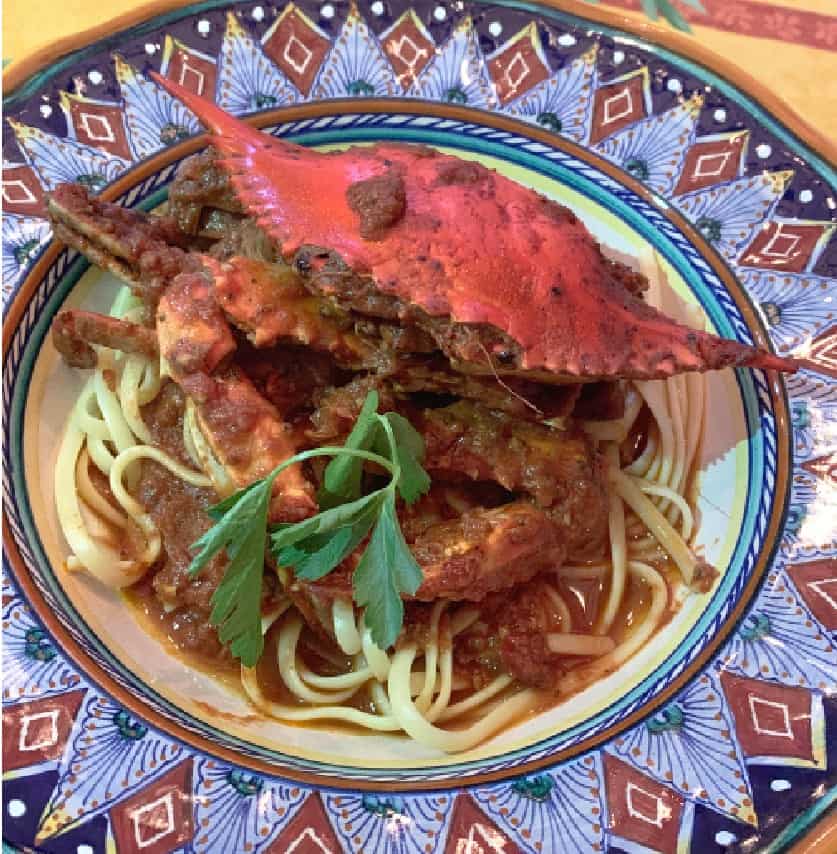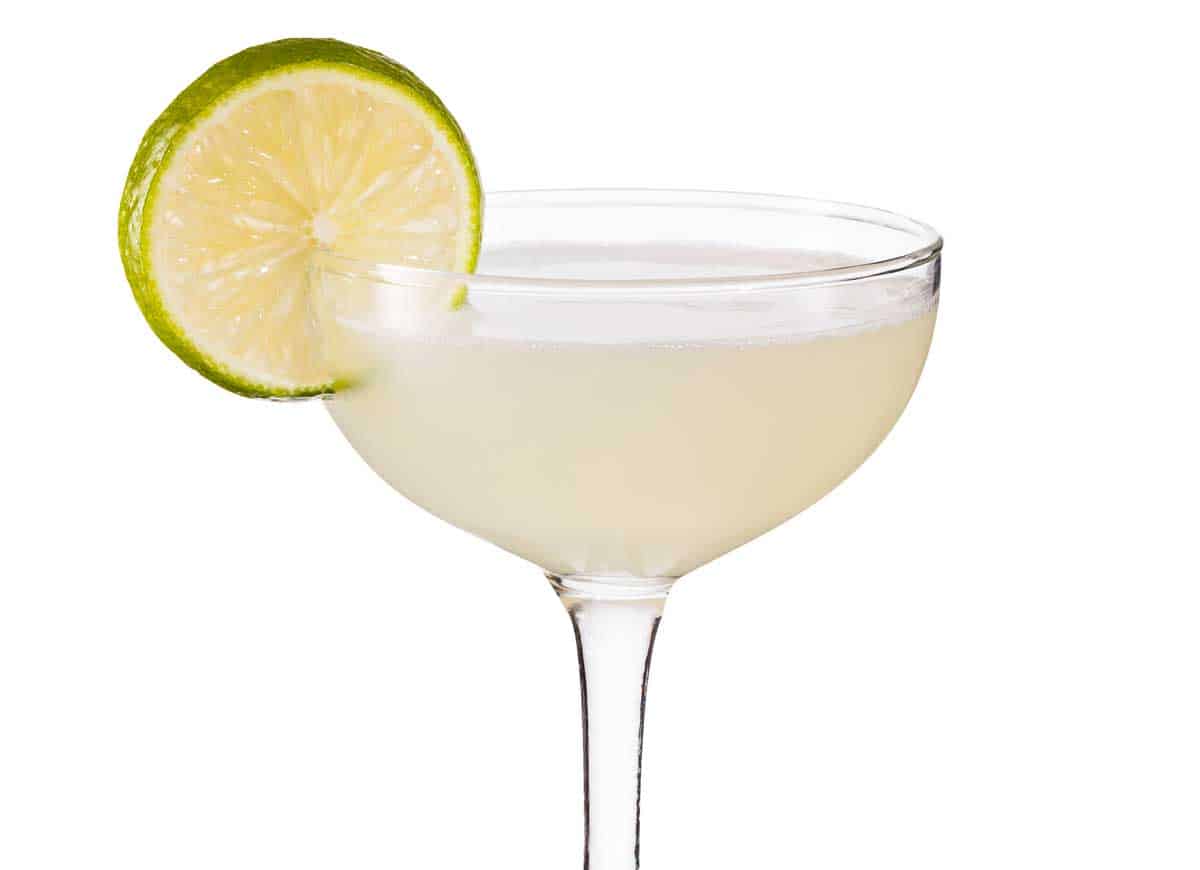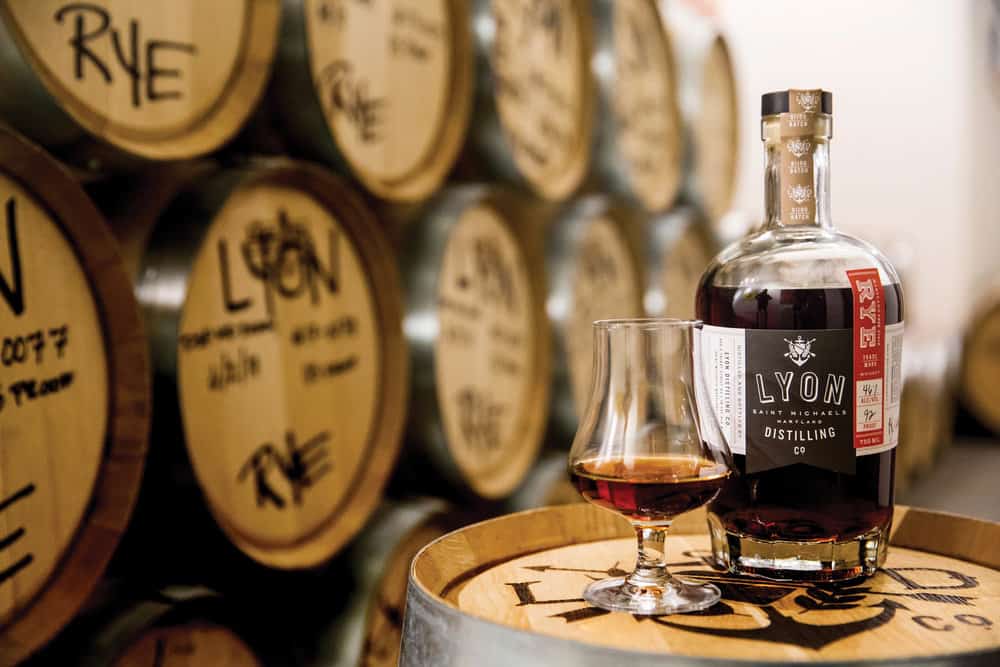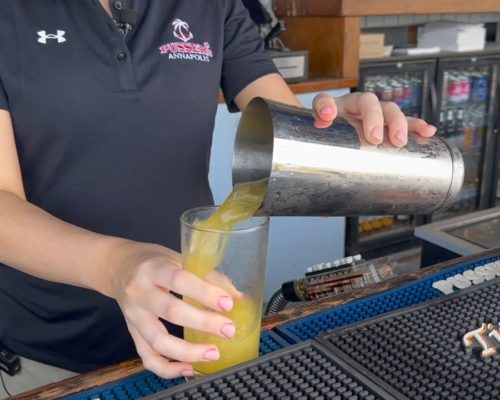It makes a delicious mess—on your blouse and chin, the plate awash in red, and the tablecloth speckled crimson from end to end. And unless you were born into it—typically with a name that ends in a vowel and roots in the old Baltimore waterfront neighborhoods—chances are you’ve never tasted it.
The dish is crabs and spaghetti: blue crabs simmered in homemade tomato sauce and served over pasta. And an extra Michelin star if you do like my cousin Cindi Hemelt Gallagher of Severna Park and make the spaghetti from scratch.
“The first story I hear about crab sauce is its unique family tradition. It differs from family to family,” said Vince Pompa, a Little Italy native and former chef at Chiapparelli’s on High Street, where he prepared the meal on “no meat” Catholic Fridays.
When the meal was served at the family home, said Pompa, “There was bread for dunking along with antipasti, stuffed peppers, marinated vegetables, homemade wine, and lots of relatives.”
Bottom line, said Pompa: “It’s meant to be shared. That’s the heart of it.”
The heart of the Pompa family was Vince’s late mother, the former Lucy Palmere, known as the Ravioli Queen of St. Leo’s Church in Little Italy. “Miss Lucy” Pompa died in 2015 at age 96.
The Chesapeake crab population has declined greatly since the late matriarch’s Depression-era girlhood, when the fish market was off Pratt Street and seafood was cheap. The harvest, now regulated, has remained somewhat constant.
Some 70 million pounds of blue crab were caught in the Chesapeake and its tributaries in 1930, according to the
U.S. Bureau of Fisheries. A little more than a year ago, that number was estimated at
61 million pounds, down a bit from previous years.
The majority, of course, are steamed the Maryland way. A few turn into crab spaghetti: Females are dropped in the soup pots, sometimes spiced with cabbage for a bit of tang. The least of each year’s haul takes a final swim in tomato sauce.
“It was a treat on Fridays in the summertime,” remembered my father, Manuel (Italian on his mother’s side from old Highlandtown), who prepared it many times with crabs he and a tugboat buddy caught in the Wye River.
Cousin Cindi said her late mother (my “Aunt Treesey”) made the meal with crabs caught on Back River at the Hemelt family shore home. “She’d pull open their backs and pretty much drop them alive in the sauce,” said Gallagher, noting, of course, that the “lungs” were scraped off while keeping the digestive glands known as “mustard.”
With the brackish water and “juice” that seeps from freshly caught crabs, the sauce is somewhat thinner than recipes using meat, and, with a touch of crushed red pepper and sometimes capers, piquant.
As Vince Pompa said, every family with a tradition of crabs and spaghetti has its own approach. Here is the interpretation of La Famiglia Sapia, longtime Ocean City restaurateurs and owners of DaVinci’s restaurant on the boardwalk at Atlantic Avenue.
About 25 years ago or thereabouts, attorney Ralph L. Sapia, 54, inherited the recipe from his father Giacomo, who went by James. When the elder Sapia died, the resort’s Downtown Association named their annual spaghetti dinner in his honor. Crabs and spaghetti have decidedly never been on the menu of the charitable event.
“We ate it when I was a kid, and when I asked Dad why we didn’t do it anymore, he said it was too messy—the messiest meal ever,” said Sapia, who recently made the dish in his Baltimore County home after work, still wearing his barrister’s bowtie.
“My father said it was simple. ‘You just put the crabs in your sauce and then cook the [expletive] out of them like you do tripe.’” It’s not quite that simple, though theirs is radically different from the approach used by my father and cousin Cindi.
Sapia only uses males, believing that eating the females (even though they’re already at market) is unsustainable.
He steams the crabs for 8–10 minutes before stewing them for up to eight hours; until, he said, “the shells are like paper” and the taste of the crab has thoroughly permeated the sauce.
Sapia makes the dish about twice a year, always inviting friends, often without telling his guests what they’ll be eating to get the thrill of their surprise. The meal became part of his repertoire when a beach friend named Jerry Greenspan—son of a Boardwalk arcade owner and Holocaust survivor named Harold—brought up the dish
one day.
The mother of one of the arcade employees had brought a big pan of the dish to the ocean one summer to feed her daughters and their friends.
“It was enough to feed 10 people and I loved it,” said Greenspan, who, craving more, asked his buddy Sapia if he knew about it. No one else in Ocean City, said Greenspan, had heard of it. Sapia followed his father’s instructions (verbal, too simple to write down) and the pals enjoyed the meal together.
“The best part of that dish is sucking the meat and the sauce out of the shells,” said Sapia.
Pompa agrees. “The sweetness of the crab is absorbed by the sauce. Then you get to do what all Baltimoreans are best at—picking through the jumbo lump meat and cracking the sweet claws.”
Greenspan last had the meal a quarter-century ago. He might soon be giving his buddy Sapia a call.
Ralphie’s Crabs and Pasta
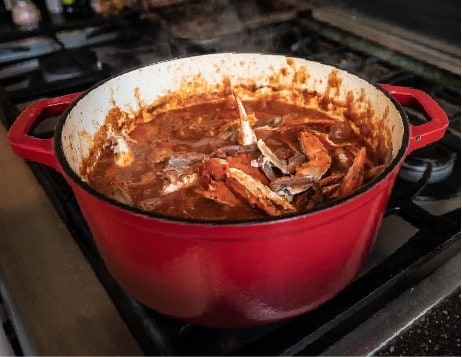
INGREDIENTS
1/2 dozen large crabs
Sauce:
1 small/medium onion
2 Tbsp garlic (fresh or minced in jar)
1 cup Italian seasoning (McCormick or Sons of Italy)
2 cans crushed tomatoes
- Steam crabs for about 10 minutes without seasoning, to dispatch them.
- Make the sauce: Cover the bottom of a pot with olive oil. Add onions and let simmer; once translucent, add garlic and brown (garlic cooks quickly so watch it closely). Add tomatoes and seasoning. Cook on high heat until it comes to a rolling boil—keep stirring, so the sauce doesn’t stick. Once boiling, turn the heat down to a simmer and cover.
- Add the crabs: Leave the claws and fins on and remove the top shell. Take off face and lungs (devil) and discard. Break the crab in half (you will have two halves with claws and fins). Put crabs in sauce, making sure to add all the fat (mustard); I also include the top shell.
- Cover and bring to a slow boil and let it cook for about an hour, stirring frequently. Turn to a low heat for about two hours. Simmer for as long as possible (best to start in the morning so you get 8 hours). Serve and eat, being careful not to wear your nicest shirt.

